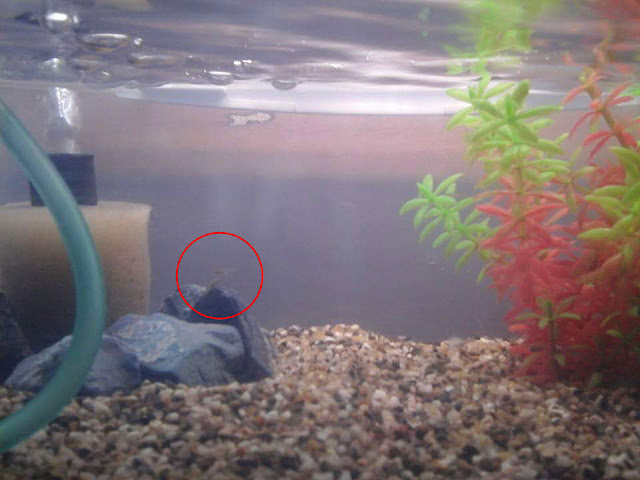There is an old saying that goes something like, “Give a man a fish and you feed him for a day. Teach a man to fish, and you feed him for a lifetime.” To an aquarium hobbyist, a more suitable quote befitting of such person like myself should be, “Buy yourself a fish and you have a fish to take care of. Learn to breed fishes and you’ll have a fish to sell later on.”
I kid.
I have a pair of tropical fish called, Swordtail Fish, which I bought from the PNG Gardener, here in Port Moresby, Papua New Guinea. They are livebearers, which means the female swordtail can bear little fishes in its tummy as opposed to other fishes that spread eggs near the surface of water.
To breed this kind of fish is easy; one must only need a big plastic bin or an aquarium the size of 42 Liters or more. I chose a bin that is slightly translucent so I can check on them from time to time. In this bin, I placed a male and two female swordtails. You can see that I put in some rocks and plastic plants so there will be plenty of room for the baby swords to hide after the mother sword gives birth to them.
I kid.
I have a pair of tropical fish called, Swordtail Fish, which I bought from the PNG Gardener, here in Port Moresby, Papua New Guinea. They are livebearers, which means the female swordtail can bear little fishes in its tummy as opposed to other fishes that spread eggs near the surface of water.
To breed this kind of fish is easy; one must only need a big plastic bin or an aquarium the size of 42 Liters or more. I chose a bin that is slightly translucent so I can check on them from time to time. In this bin, I placed a male and two female swordtails. You can see that I put in some rocks and plastic plants so there will be plenty of room for the baby swords to hide after the mother sword gives birth to them.
I also cut an opening at the center of the bin’s lid and had it covered with glass. If I want to feed the fishes, I just slide the glass open. A 3-Watt fluorescent bulb is enough to illuminate the bin.
I used a 3.5-Watt Eheim Pick Up 45 submersible aquarium filter for keeping the water clean and to maintain a considerable amount of good bacteria that holds the ammonia levels in check. Ammonia build-up is caused by the accumulation of fish poop and from uneaten fish food.
These are the pair of swordtails in the bin. The fish in the foreground is the female and the one at the back is the male. It is easy to distinguish a male from a female swordfish because the male always has a sword-like tail fin.
This is a male swordtail. The sword-like tail fin is slightly visible. Keep the bottom of the plastic bin gravel-free so it’s easier to remove fish poops that get accumulated at the bottom. Swordtails are a notorious poop-machine aquarium fish and they pollute the aquarium twice as fast as an egg-laying fish. That’s why I like the egg-laying fish more.
An example of egg-laying fish is the Gourami.
This is one of the Gouramis in my other aquarium. A Gourami of this kind always have two dots in its body. But its eyes are also as big as the dots so it’s easy to confuse the eyes with the dots, hence it’s also called, the Three Spot Gourami.
I also have a pair of rainbow fish, which are also an egg-laying type of aquarium fish. This fish is native to Papua New Guinea.
I also have three pieces of the Sogeri Koi. These are also egg-layers.
Now, going back to our topic, it might take a few days or weeks before the pair of Swordtails can get along with each other. Nevertheless, in just two or three months, you’re going to start seeing little baby swords darting through the plastic plants. You’ll need to scoop them out and separate them from the parents.
I have a 1-Liter plastic bin that I modified to serve as the nursery for the babies as they grow to juveniles. The parent swords will eat the babies if they get a chance so it is best to separate the latter from the former.
Finally, here is a baby sword swimming peacefully in the nursery. The other baby swords are hiding in the substrate and behind the plastic plant. I encircled the part of the photo where the baby sword is swimming.
Baby swordtails are not orange during infancy. They only get the peculiar orange colors when they grow a bit bigger. To keep the waters clean and liveable in the nursery, I used a sponge filter that I made by myself.
While breeding swordtails is a bit easy, breeding egg-laying fishes is quite challenging. I’ve tried on many occasions to breed them but I haven’t had any luck thus far.











You will need to be careful to keep your frozen foods.
ReplyDeleteFrozen food could become tainted if omitted too long. Your betta fish will relish a nutrient enriched diet
through frozen foods.
Very cool. Any fish for sale in pom?
ReplyDeleteVery nice fish. Any for sale in pom?
ReplyDeleteThat is really good and informative post, you have provided all the details about Swordtails. Thanks for sharing such informative blog with us. If you like you can visit fish aquarium
ReplyDelete